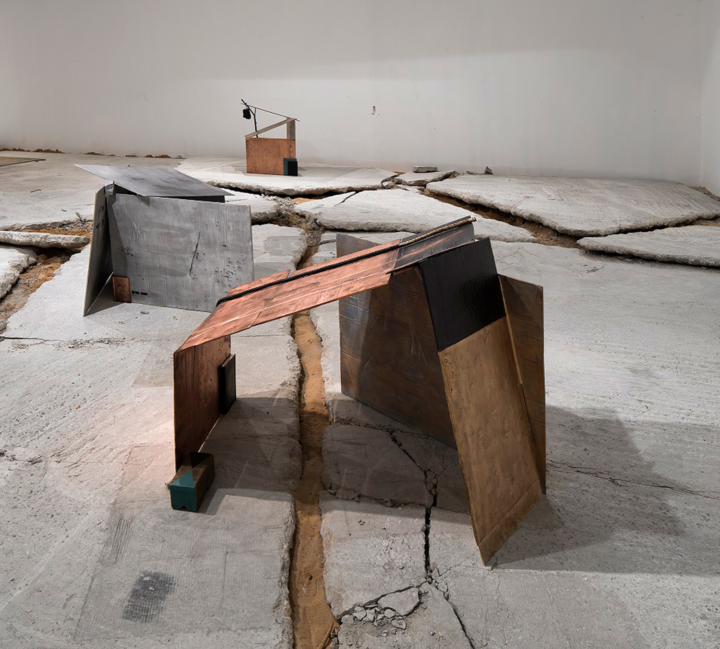The most striking element in Tatiana Trouvé’s current exhibition “The Great Atlas of Disorientation” is the sharp contrast between its two main environments. Each creates a distinctive mode of disorientation through an entirely different aesthetic, while also being inconsistent in their artistic quality.
In the first space, the concrete floor has been shattered as if by an earthquake. Amid the cracks and ruins are scattered various structures, cast in bronze, aluminum, and copper, that mimic makeshift shelters made of used cardboards. These vagabond lodgings are embedded with various objects: books and diaries, as well as maps of ancient and current migration routes, celestial navigation diagrams, geological timelines, sketches of solar systems, and phylogenetic evolution charts. It is a culturally and historically-varied display of attempts at cartographically representing our worldly time and space, as well as its geopolitics. Other cast objects such as blankets and cardboard sheets peep out of the ruined ground, as if swallowed by the chaos. The scenic handling of the floor grants the space a catastrophic, postapocalyptic air, as well as a heightened sense of theatricality. Here, Trouvé’s crafted structures, some exhibited previously at the 15th Istanbul Biennial, lose their intensity and become mere props in a set, referring a bit too literally to the contemporary refugee crises.

The second installation, called “Prepared Space,” is a white, luminous room dissected by long slits running throughout its floor and walls and confusedly converging into multiple vanishing points. The arrangement is based on one of the ancient space navigation maps inscribed on the structures in the previous room; the image has been translated into a mathematical, almost abstract 3-D environment, turning the room into a kind of digital “non-place” inhabiting a sense of “non-being.” The only disruption to this sterile plateau are triangle-shaped spacers (the kind usually used in construction), which are cast in bronze and inserted into the slits as if supporting the unfinished structure.
Trouvé’s work is usually discussed in relation to its uncanny manipulation of space and time, while her use of casting, in which everyday objects are turned into illusionary, hyperrealist sculptures, is often understated. These reverse ready-mades function more effectively in the second room than in the first, as they create a disturbance in the coherence of the mise-en-scène, baffling the viewer’s sense of matter and space. Trouvé’s transformation of mundane artifacts into shiny metal affords them durability but deprives them of their functionality, exposing a root of immigration and displacement not only in the dispossession of land but also resources.

